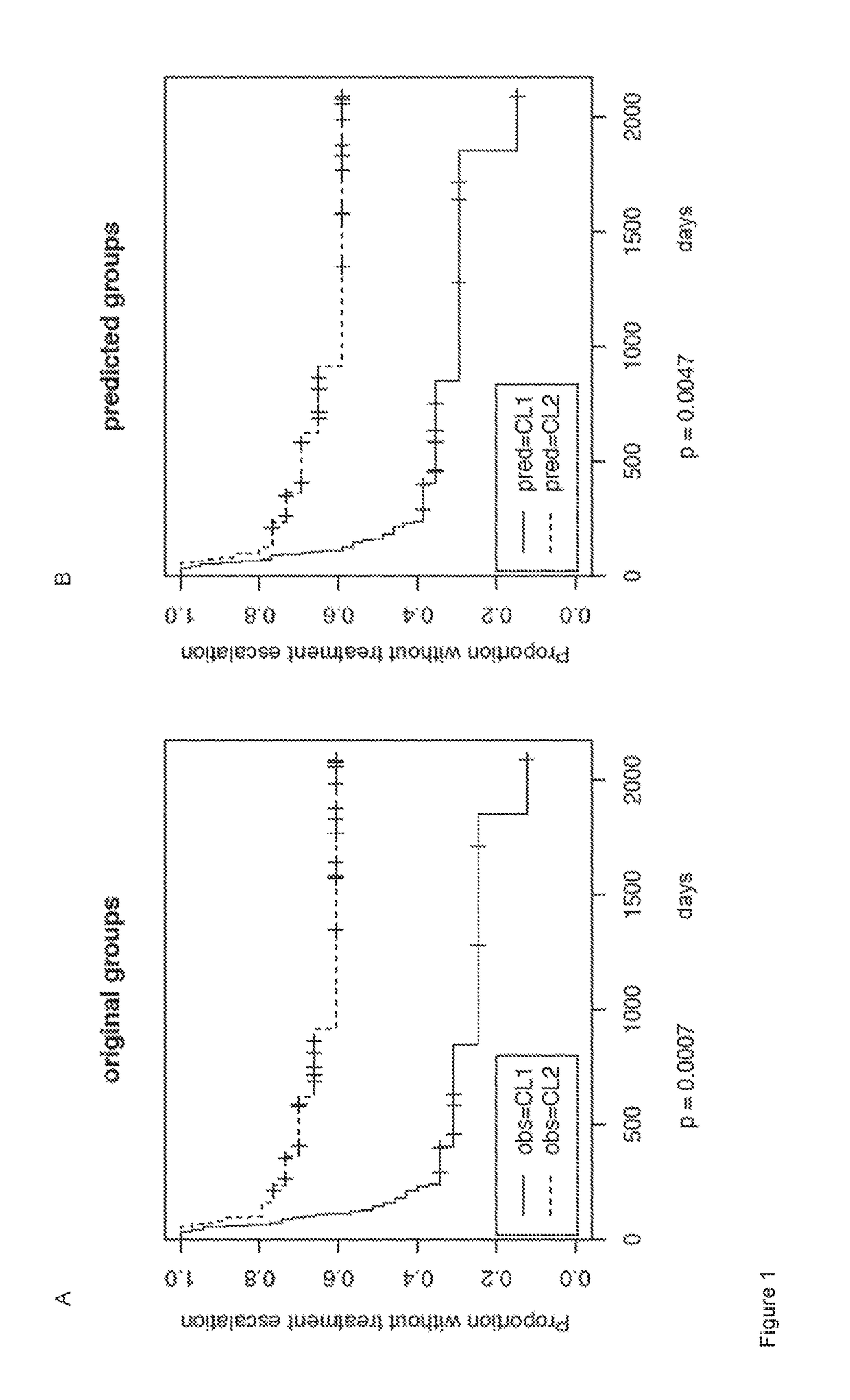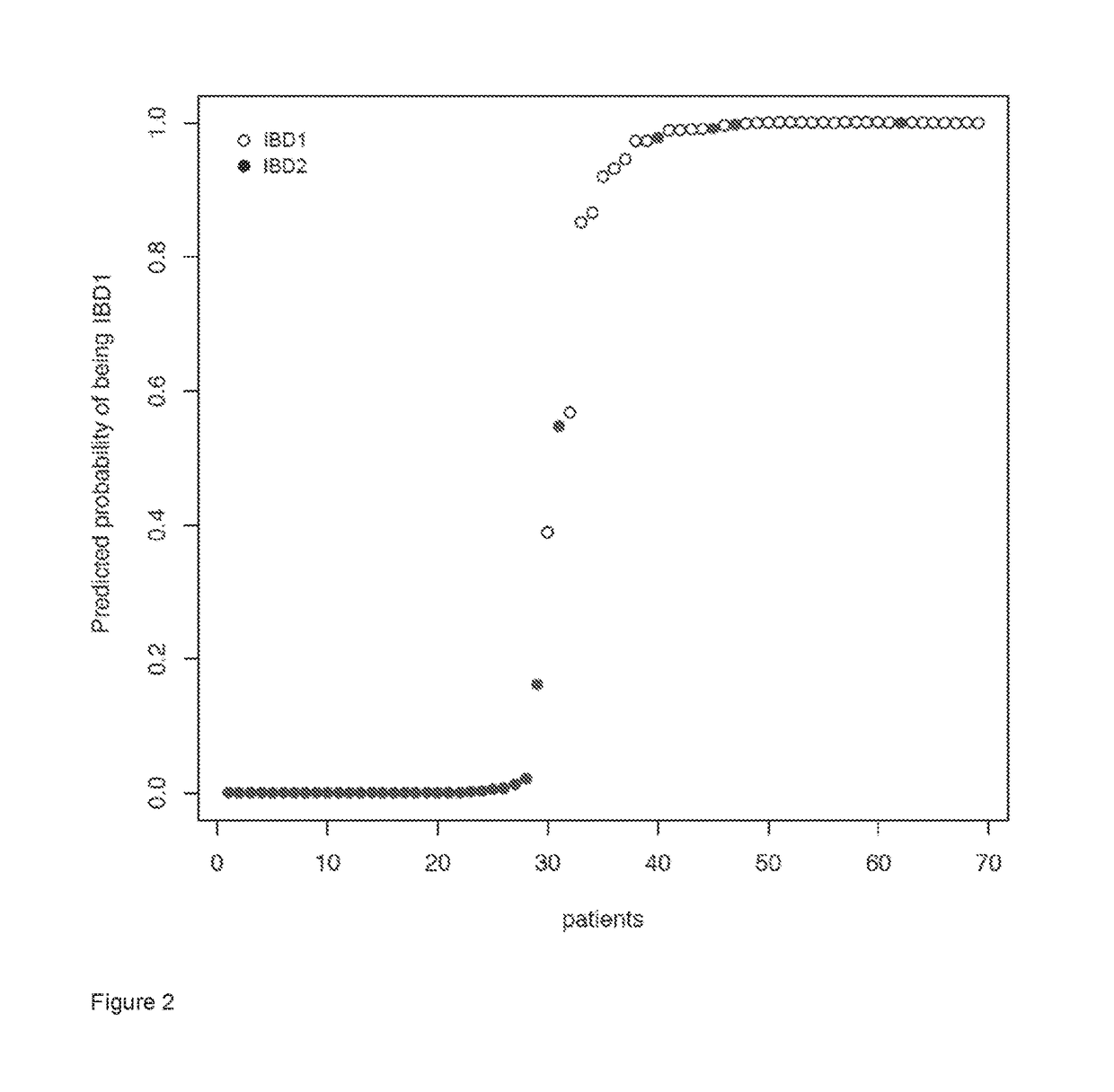Biomarkers for Inflammatory Bowel Disease
- Summary
- Abstract
- Description
- Claims
- Application Information
AI Technical Summary
Benefits of technology
Problems solved by technology
Method used
Image
Examples
example 1
Identification of an IBD1 / IBD2 F Gene Signature in Whole Blood
[0136]Materials and Methods
[0137]Patient Recruitment for Gene Expression Profiling
[0138]Sixty-nine patients with active Crohn's disease (CD) (n=39) and ulcerative colitis (UC) (n=30) were recruited prior to commencing treatment and follow-up data subsequently collected as already described in (Lee et al., 2011). Ethical approval for this work was obtained from the Cambridgeshire Regional Ethics Committee (REC08 / H0306 / 21). All participants provided written informed consent.
[0139]CD8+ T Cells Samples
[0140]CD8+ T cells were positively selected from blood samples obtained from the sixty-nine patients according to the methods described in (Lyons et al., 2007) and RNA was extracted using RNEasy Mini Kits (Qiagen) according to the manufacturer's instructions, as previously described in (Lee et al., 2011).
[0141]Whole Blood Samples 2.5 ml of whole blood was collected from the sixty-nine patients into RNeasy mini or PAXgene Blood R...
example 2
Optimisation of the Whole Blood Classifier for RT-qPCR Analysis
[0154]The genes identified in Example 1 were taken forward to real time qPCR assay development, where the final content of the whole blood classifier (16 informative and 2 reference genes) was optimised and finalised. The informative genes forming part of this classifier are listed in Table 2 below.
[0155]Through being detectable in whole blood by methods such as RT-qPCR, stratification of patients using this whole blood gene classifier will be simpler and more cost effective than tests requiring the isolation of particular cell types prior to determining gene expression, as described in WO2010 / 084312, for example.
[0156]Furthermore, the whole blood gene classifier is expected to have wide-ranging healthcare benefits, including leading directly to major improvements in IBD management; enabling patients with aggressive disease to receive appropriately potent therapy from diagnosis, while ensuring that those with indolent di...
example 3
Independent Validation of the qPCR-based Whole Blood Assay
[0157]Independent validation of the prognostic performance of the 16 gene classifier identified in Example 2 was then performed using a second, independent, cohort of 85 newly diagnosed IBD patients from 4 sites around the UK (Cambridge, Nottingham, Exeter, and London). Analysis of whole blood gene expression using the qPCR-based test developed in Example 2 replicated the prognostic stratification seen in the discovery cohort with a IBD1 / IBD2 Hazard ratio of 3.52 (95 percent confidence interval [CI]: 1.84 - 6.76, P=0.0002, FIG. 3). This performance compares favourably to that of existing gene expression based in vitro diagnostic tests. For example, the Hazard ratio for Oncotype DX, a gene expression diagnostic that predicts breast cancer recurrence, is 2.81 (95% CI: 1.70 4.64) (Paik et al., NEJM, 2004).
PUM
| Property | Measurement | Unit |
|---|---|---|
| Force | aaaaa | aaaaa |
| Force | aaaaa | aaaaa |
| Force | aaaaa | aaaaa |
Abstract
Description
Claims
Application Information
 Login to View More
Login to View More - Generate Ideas
- Intellectual Property
- Life Sciences
- Materials
- Tech Scout
- Unparalleled Data Quality
- Higher Quality Content
- 60% Fewer Hallucinations
Browse by: Latest US Patents, China's latest patents, Technical Efficacy Thesaurus, Application Domain, Technology Topic, Popular Technical Reports.
© 2025 PatSnap. All rights reserved.Legal|Privacy policy|Modern Slavery Act Transparency Statement|Sitemap|About US| Contact US: help@patsnap.com



